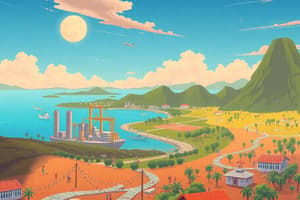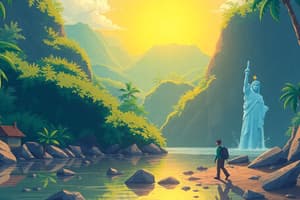Podcast
Questions and Answers
Es una ciencia que trata con los _____ y las necesidades humanas, y de comoutilizar estos recursos para lograr satisfacer las ilimitadas y crecientes necesidades.
Es una ciencia que trata con los _____ y las necesidades humanas, y de comoutilizar estos recursos para lograr satisfacer las ilimitadas y crecientes necesidades.
recursos
¿Qué es Economía?
¿Qué es Economía?
Forma en que la sociedad gestiona los recursos escasos
Cuál es la diferencia entre Microeconomía y Macroeconomía?
Cuál es la diferencia entre Microeconomía y Macroeconomía?
- Microeconomía: Análisis de las unidades individuales (consumidor,productor, industria, mercado). Macroeconomía: Analiza los grandes agregados económicos, como el producto, el consumo, la base monetaria, el empleo.
- Microeconomía: Teoría de los Precios y recursos. Macroeconomía: Se le denomina la Teoría del Ingreso Nacional, debido a suinterés por determinar como se forma la producción nacional y que variables influyen en ella.
- Microeconomía: Explica la composición y laasignación del producto total. Macroeconomía: None
- All of the above (correct)
Los modelos son afirmaciones que permiten simplificar la realidad y que no están sujetos a comprobación
Los modelos son afirmaciones que permiten simplificar la realidad y que no están sujetos a comprobación
Los supuestos permiten comprender el mundo más fácilmente.
Los supuestos permiten comprender el mundo más fácilmente.
Defina 'El costo de oportunidad'
Defina 'El costo de oportunidad'
Cuáles son los componentes del costo de oportunidad.
Cuáles son los componentes del costo de oportunidad.
¿Qué ocasiona cambios (desplazamientos) en una Curva Posibilidades Máximas de Producción?
¿Qué ocasiona cambios (desplazamientos) en una Curva Posibilidades Máximas de Producción?
El sistema de mercado es lo mismo que el sistema capitalista.
El sistema de mercado es lo mismo que el sistema capitalista.
Cuáles son las ventajas del sistema de mercado
Cuáles son las ventajas del sistema de mercado
Flashcards
¿Qué es economía?
¿Qué es economía?
Study of how society manages its scarce resources.
Escasez
Escasez
The limited nature of society's resources.
Costo de oportunidad
Costo de oportunidad
What you give up to obtain something else.
Microeconomía
Microeconomía
Signup and view all the flashcards
Macroeconomía
Macroeconomía
Signup and view all the flashcards
Modelos
Modelos
Signup and view all the flashcards
Supuestos
Supuestos
Signup and view all the flashcards
Análisis positivo
Análisis positivo
Signup and view all the flashcards
Análisis normativo
Análisis normativo
Signup and view all the flashcards
Bienes
Bienes
Signup and view all the flashcards
Necesidades
Necesidades
Signup and view all the flashcards
Recursos
Recursos
Signup and view all the flashcards
Problema económico
Problema económico
Signup and view all the flashcards
Sistema económico tradicional
Sistema económico tradicional
Signup and view all the flashcards
Sistema económico de mando
Sistema económico de mando
Signup and view all the flashcards
Sistema de mercado
Sistema de mercado
Signup and view all the flashcards
Frontera de Posibilidades de Producción
Frontera de Posibilidades de Producción
Signup and view all the flashcards
Costo explícito
Costo explícito
Signup and view all the flashcards
Costo implícito
Costo implícito
Signup and view all the flashcards
Curva de transformación
Curva de transformación
Signup and view all the flashcards
Study Notes
- Microeconomics is being discussed.
- The presenter's name is Diego Campos Campos and their phone number is 2667-8152.
- The date of the presentation is September 2, 2024.
Forming Groups
- Groups should consist of 5 people.
Evaluation Breakdown
- First Exam will be 30% of the final grade.
- Second Exam will be 30% of the final grade.
- Quizzes and homework will be 25% of the final grade.
- Research (exhibition) will be 15% of the final grade.
- The total evaluation will be 100%.
Exposition Themes and Suggested Delivery Dates
- Consumer Price Index, goods that make up the basic basket in Costa Rica, modifications (Chapter II).
- Goods with price controls in Costa Rica (Chapter II).
- The role of ARESEP in Costa Rica (Chapter II).
- Impact of taxes and subsidies in the market: (effect on price and consumption) (Chapter II).
- Impact of value-added tax (Chapter V).
- Impact of taxes and subsidies in production (Chapter V).
- Recope and its role in determining fuel prices (Chapter V).
- What is income tax? Impact on the company? (Chapter VII).
Recommended Bibliography
- Case Karl, Fair Ray, Oster Sharon (2012). Principles of Microeconomics. Tenth edition, Pearson.
- Hall Robert and Lieberman Marc. (2005). Microeconomics, principles and applications. Third edition, Thomson.
- Samuelson Paul, Nordhaus William. (2010) Microeconomics with applications to Latin America. Edition 19. Editorial McGraw-Hill.
- Hirshleifer Jack. Microeconomics: theory and applications. Editorial Prentice may. Third edition in Spanish. Mexico 1988.
- LeRoy Miller, Roger; Meiners, Roger E. Microeconomics. Editorial McGraw-Hill. Third edition in Spanish.
- Mankiw Gregory N. Principles of economics. Editorial McGraw-Hill.1998.
- Rosales, Obando José. Elements of Microeconomics. EUNED. San José. 1984.
Introduction to Economics
- Economics is the study of how society manages its scarce resources.
- Greek origin: "oikonomia"
- Oikos translates to House (patrimony).
- Nemein translates to Administer.
- Economics is the way in which society manages scarce resources.
- Needs -> Resources -> Goods and Services.
Definition of Economics
- Science dealing with resources and human needs, and how to use resources to meet unlimited and growing needs.
- Science dealing with human needs and their satisfaction, also dealing with social phenomena arising from human activities that produce and use wealth.
Principles of Economics
- Individuals face trade-offs (Efficiency and Equity).
- The cost of something is what you give up to get it (Opportunity Cost).
- Rational people think at the margin (Small Adjustments, Additional Variations).
- Individuals respond to incentives (Costs, Benefits).
- Trade can improve everyone's well-being (Free and Without Restrictions).
- Markets are usually a good way to organize economic activity (Economic Systems).
- The state can sometimes improve market outcomes (Market Failures, Externalities).
- A country's standard of living depends on its ability to produce goods (Productivity, GNP, GDP).
- Prices rise when the government prints too much money (Inflation, Deflation).
- Society faces a short-run trade-off between inflation and unemployment (Inflation-Unemployment Trade-off).
Difference Between Microeconomics and Macroeconomics
- Microeconomics analyzes individual units, such as the consumer, producer, industry, and market; it focuses on the theory of prices and resources, explaining the composition and allocation of total product.
- Macroeconomics analyzes large economic aggregates, such as product, consumption, monetary base, and employment; it is known as the Theory of National Income due to its interest in determining how national production is formed and which variables influence it.
Use of Models and Assumptions
- Used to help think like economists.
- Economists use objectivity and the scientific method: observation, theory, observation.
- Models are statements that simplify reality and are not subject to verification.
- Examples of models include: diagram of the circular flow of economic activity, frontier of maximum production possibilities, model of demand and supply.
- Assumptions allow one to understand the world more easily and to study phenomena.
- Examples of assumptions include economic rationality and ceteris paribus.
Positive vs Normative Analysis
- Positive Analysis (Objective): Affirms what is and not what should be.
- Normative Analysis (Subjective): Affirms what should be; involves value judgments.
- Needs → Resources → Goods and Services
Goods, Needs, and Resources
- Goods are anything that satisfies a human need.
- They are typically associated with tangible items such as rice, meat, cars, roads, buildings, computers, haircuts, and bus services.
- Categories of classification: Durable and non-durable, Private and public, economic/free, consumer and capital.
Needs
- Needs are ideas, sensations, or thoughts of lacking a good or service
- Basic, Cultural, Created.
- Needs are unlimited, they grow with time, and are ranked in a hierarchy.
Resources
- Resources are the means that allow for obtaining goods and services in a production process
- Labor, land, business/entrepreneurial capacity, capital
- Resources can be described as limited/scarce and versatile.
Economic Problem
- Scarcity and choice
- There is a desbalance.
- Limited/Scarce Resources vs. Unlimited Needs.
- This leads to making key economic decisions such as:
- What to produce? (problem of hierarchy).
- How to produce? (problem of organization).
- For whom to produce? (problem of distribution).
Economic Systems
- Economic systems answer the question of how the economic problem is solved.
- Using tradition through custom.
- Decisions are mandated by individuals.
- Market based decisions determined by cost.
Opportunity Cost
- Opportunity cost is the consequence of choice.
- The value of the second-best option that is rejected.
- It is the sacrifice in the production of a good to obtain more of another, or the sacrifice in consumption when choosing a particular good and foregoing others.
Opportunity Cost Components
- Explicit Cost: Costs that require cash outlay.
- These include the cost of raw materials, salaries, and accounting costs.
- Implicit Costs: Costs that do not require cash outlay.
- Involve consumption of resources already owned that do not involve monetary disbursement.
- Involves losing the ability to earn when dedicating time to a specific activity.
Production Possibilities Frontier (PPF)
- A model used as to show the maximum production/Transformation.
- Where "A" and "B" are used as labels on the graphic.
- The curve is dependent on resources and available technology.
Curve of Transformation Assumptions
- Only two goods are produced; this is assumed for simplification purposes.
- Resources are scarce. If scarcity decreases, the curve of transformation increases.
- The technology remains the same at the time of analysis. If technology improves, the curve increases.
- There is full employment of resources. If resources are not fully utilized, production will fall within the curve.
- Resources and goods can be divided. This assumption specifies that portions of resources can be moved from the production of one good to another, allowing for fractions of production and maintaining infinitesimal continuity in the transformation curve.
- Specialization and versatility of resources allows resources to develop some specialization while still being versatile and of multiple use.
Maximum Production Possibilities
- The following costs can be divided in three categories.
- Increasing costs.
- Cost increases in the graphic.
- Decreasing costs.
- Cost decreases in the graphic.
- Constant costs.
- Cost are the same throughout.
Task
- What causes the changes (displacements) in a Curve possibilities maximum production?
Market System
- Capitalist system, price system, free enterprise system and market system.
- It is the most efficient system.
- Presents the greatest degree of individual freedom.
- Involves private property and is automatic.
Circular Flow of economic activity
- Consists of goods and Services and market of goods and services.
- The Families are L, K, T, E
- Where, L = Land, K = Capital, T= technology, E = expertise.
- Payments are wages, benefits, interest and rent, w, b, i, r
- The market of resource is the Land, Capital, Technology and Expertise.
Task
- Look for the advantages of the market system. (Explain)
- Look for the disadvantages of the market system (Explain)
- There will be an oral call.
Studying That Suits You
Use AI to generate personalized quizzes and flashcards to suit your learning preferences.




